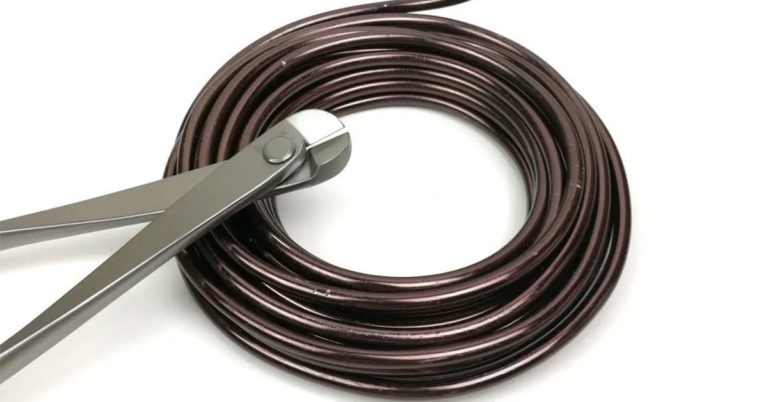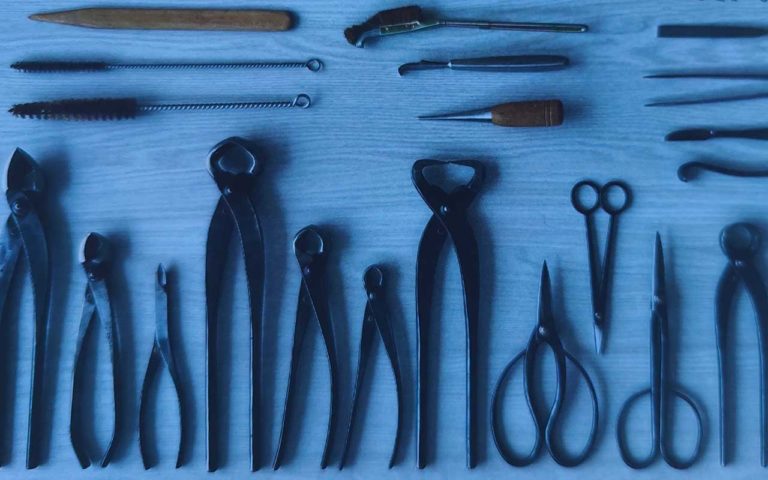I remember when I got my first bonsai tree, a juniper tree to be precise, I didn’t know much about bonsai maintenance. A few years later, I know a bit more.
Yes, it takes years to master the art of bonsai. Still, if you know the basics, you’ll be well on your way to unlocking the secrets of this ancient and captivating horticultural practice.
Patience and dedication are essential traits for those who embark on the journey of bonsai cultivation.
While it may seem like a daunting task, understanding the fundamental principles of bonsai care can lay a strong foundation for your own miniature arboreal masterpiece.
Let’s dive into the basics of bonsai caring!
Selecting the Right Bonsai Tree
I’m assuming you haven’t purchased your bonsai yet. If so, skip this paragraph!
Factors to Consider When Buying a Bonsai Tree
When buying a bonsai tree, there are several factors that one should consider.
The first is the shape of the tree. It must be harmonious:
- The trunk must me larger at its base.
- The main branches must be bigger.
- The roots must be well distributed in the pot.
- The root ball must not be dried out.
You should also onsider the overall health and condition of the tree. Look for signs of disease or pest infestation, as these can be difficult to treat and may impact the tree’s longevity.
Finally, consider the price of the tree. Bonsai trees can range in price depending on their size and species. Set a budget and find a tree that fits within your price range.
Matching Bonsai Species to Your Environment
It is essential to consider the climate and growing conditions in your area. Different species of bonsai have different temperature and humidity requirements, and not all species can thrive in every climate.
For example, tropical species like the Ficus or the Chinese Elm require warmer and more humid conditions, while coniferous species like the Juniper or Pine are more resistant to cold temperatures.
It is also crucial to consider the amount of sunlight that your bonsai will receive, as some species prefer full sun, while others require more shade. I’ll come back to it below.
Keep in mind that most species are not suitable for indoor cultivation and thrive better outdoors.
Basic Tools and Materials
Yes, you need tools to take care of your bonsai. Waterind is not enough. No worries, you don’t need much to get started.
Essential Equipment for Bonsai Caring
Essential equipment for bonsai caring includes a variety of tools and supplies that are necessary for maintaining and shaping the bonsai trees.
One of the most important tools is a pair of bonsai pruning shears, which are used to trim and shape the branches and foliage of the tree.
Wire cutters are also essential, as they are used to cut and shape the wires that are used to train and style the branches.
A bonsai rake is another crucial tool, which helps in maintaining the root system and removing the weeds from the soil.
Finally, a set of bonsai pots of varying sizes is required to house the bonsai tree and provide him with the appropriate growing conditions.
Watering
Watering is of upmost importance when it comes to bonsai caring. Overwatering can lead to global health issues, when under-watering can lead to a quick death.
See also
Proper Watering of a Bonsai Tree
Unlike regular potted plants, bonsai trees require a careful and precise watering schedule.
One common mistake bonsai owners make is overwatering their trees. This can lead to root rot and ultimately the death of the tree.
On the other hand, underwatering can cause the bonsai to dry out and wither. So never forget to water the tree in a balanced manner.
The frequency of watering will depend on various factors such as the size of the pot, the species of the tree, and the surrounding climate.
Typically, bonsai trees require watering when the soil shows signs of dryness. I do not recommend to water your bonsai unless you see it with your eyes. I the soil looks dark and humid, to bother watering the bonsai.
It is important to thoroughly soak the soil, ensuring that water reaches every root, and then allow the excess water to drain away. This will prevent the water from becoming stagnant and causing damage to the roots. By following a proper watering routine, bonsai owners can maintain the health and beauty of their trees for years to come.
Signs of Watering Issues
One of the (very) common is improper watering. Overwatering or underwatering can lead to significant problems for the health of the bonsai.
One of the signs of overwatering is yellowing leaves that feel soft and mushy to the touch. The soil may also appear constantly damp, and there may be an unpleasant smell coming from the pot.
On the other hand, underwatering can result in wilted leaves that appear dry and brittle. The soil will be dry to the touch, and even after watering, the water may quickly drain through without being absorbed.
And of course, the bonsai may stop growing or growing at a very slow pace. In the worth case, you can expect death.
Pruning and Shaping
Shaping Techniques
Shaping techniques play a significant role in crafting the aesthetics of a bonsai tree.
One widely used technique is wiring, which involves wrapping a thin but flexible aluminum or copper wire around the trunk and branches to bend and guide their growth.
The wire can be adjusted over time to achieve the desired shape.
The other important technique is pruning, which involves trimming the tree’s foliage and branches to maintain its miniature size and desired shape.
All this helps to create the illusion of age and balance in the tree’s overall appearance
Seasonal Considerations
Different seasons bring different growth patterns and requirements for the bonsai tree.
In spring, growth is vigorous, and it is a good time to prune the tree to encourage new growth and shape the branches.
This is also the season to remove any dead or weak branches.
During summer, the tree continues to grow, but it is important to avoid heavy pruning as it can weaken the tree. Instead, focus on maintaining the shape and removing any unnecessary growth.
Autumn is the time when the bonsai enters a dormant phase, and pruning should be kept to a minimum. This is a good time to prune back any unruly branches and prepare the tree for winter.
Finally, in winter, the bonsai requires very little pruning, if any. It is mainly a time for maintenance, such as removing any dead leaves or branches.
Wiring (ligaturing)
Bonsai Branch Shaping with Wires
You wire the trunk and the branches of your bonsai as you want to manipulate the growth of branches and shape the overall design of the tree.
The process involves carefully wrapping a small gauge wire around selected branches and gently bending them into the desired position.
By using wires, you can achieve precise control over the direction and curvature of the branches, creating a more aesthetically pleasing and balanced bonsai tree.
Don’t forget: the purpose is to mimmick how the tree would evolve in its natural environment.
See also
Soil and Repotting
Choosing the Right Soil: akamada
Bonsai trees have unique requirements when it comes to soil, and using the wrong type can result in stunted growth and even death of the tree. That’s why you cannot use potting soil for your bonsai, even if you have leftover.
The best soil mix for bonsai is akadama, a type of Japanese clay. Why?
Weel, akadama has excellent water retention properties while still allowing for adequate drainage, that’s it.
It’s true that akadama can be expensive and difficult to find in some areas. Still, keep in mind your purpose: growing a tree in a pot and shaping it the most realistic way possible. You cannot do that with any kind of soil.
See also
When and How
You cannot put or buy a bonsai in its pot and expect it to thrive without repotting it.
Repotting has to be done periodically to ensure the health and growth of the tree.
The timing of repotting depends on the specific needs of the bonsai species, but generally, it is recommended to repot every one to three years for a young tree.
Signs that a bonsai needs repotting include a pot-bound root system, slow growth, yellowing leaves, and water draining too quickly.
The best time to repot a bonsai is during the spring or fall, as these seasons provide a good balance of growth and recovery.
Fertilizing
Types of Fertilizers
There are several different types of fertilizers that can be used for bonsai trees.
One type is organic fertilizer, which is made from natural materials such as composted manure, bone meal, and fish emulsion. Organic fertilizers release nutrients slowly, providing a steady supply of nourishment for the bonsai tree.
Another type is inorganic fertilizer, which is made from synthetic chemicals. I don’t recommend it.
Application and Frequency
Fertilization is an essential part of keeping Bonsai healthy and vibrant.
In general, I recommend to start fertilizing your Bonsai trees in early spring, once they have entered the active growth phase. Apply the fertilizer every two weeks.
As summer approaches and the growth rate accelerates, the frequency can be increased to once a week. Of course, follow the recommended dosage instructions to avoid over-fertilization, as this can lead to chemical burns and damage the delicate root system.
Don’t fertilize your bonsai tree in winter, as it is in its dormant phase
See also
Sunlight and Placement
Optimal Light Conditions
Bonsai trees are known to thrive in bright, indirect sunlight. Don’t put your bonsai in the direct sun, except in the morning. Too much direct sunlight can lead to leaf burn and drying out of the tree.
On the other hand, insufficient light can result in weak growth and limited foliage.
Rotate the bonsai regularly to ensure uniform light distribution and prevent the tree from leaning towards the light source.
Indoor vs. Outdoor Placement
A bonsai tree, as small as it can be, is an outdoor tree. Only a few tropical species can adapt indoor. Then it needs to be place at a window.
Pest and Disease Control
One common problem is scale insects, which are small, oval-shaped creatures that attach themselves to the leaves and stems of bonsai trees.
These pests can weaken the tree by sucking out its sap and can also lead to the growth of sooty mold.
Another issue to watch for is spider mites, tiny pests that feed on the underside of leaves and can cause discoloration and wilting.
Aphids are another common problem, as they reproduce rapidly and can cause stunted growth and deformed leaves.
Bonsai trees are also susceptible to fungal infections, such as root rot and leaf spot, which can be caused by overwatering or poor drainage.
Winter Care (If Applicable)
The first step is to stop fertilizing the tree in late summer, as this will encourage new growth that may not have enough time to harden before winter sets in.
Next, it is important to gradually reduce watering as the temperature drops. Bonsai trees are more susceptible to root rot during winter due to the cold and damp conditions, so it is necessary to strike a balance between keeping the tree hydrated and preventing excessive moisture.
Protection from freezing temperatures is another vital aspect of winter preparation. This could involve moving the bonsai to a sheltered area such as a greenhouse or garage, or providing insulation using materials like mulch or horticultural fleece.
Avoid pruning or wiring the tree during winter, as this can further stress the bonsai.


